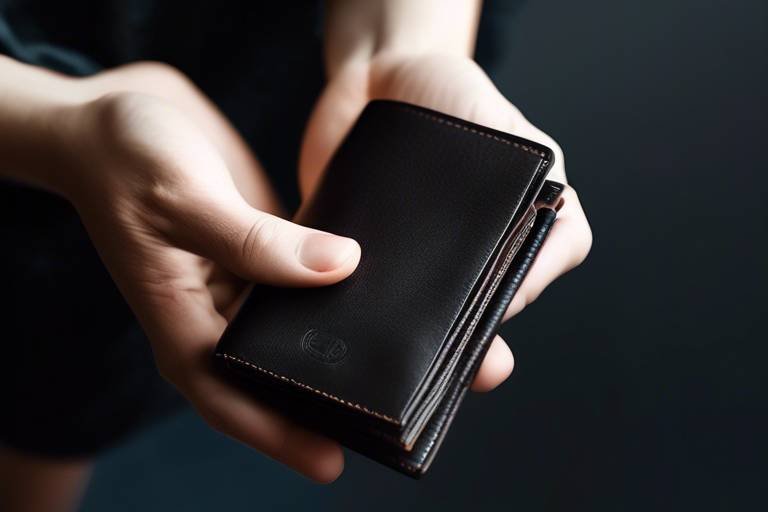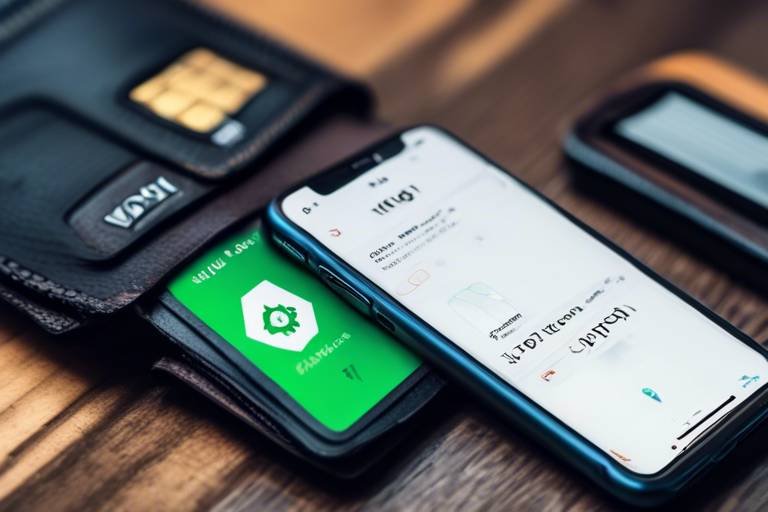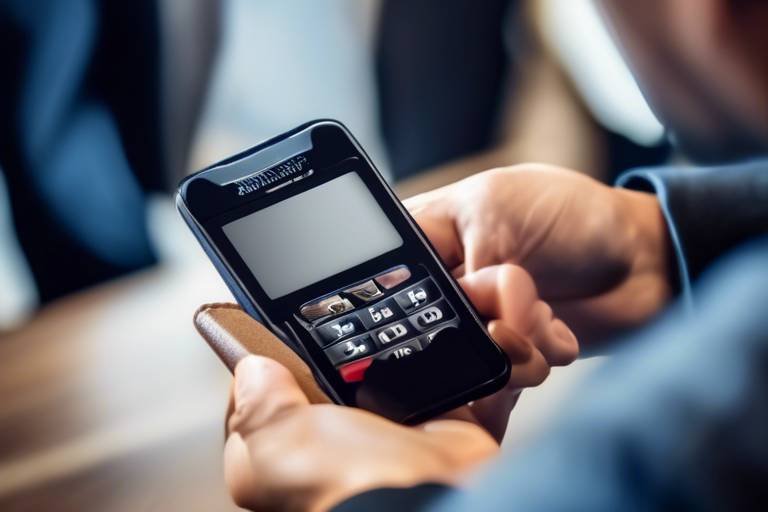How to Create a Wallet for Your Online Store
In today's fast-paced digital world, having an efficient payment system is not just a luxury; it's a necessity. Creating a digital wallet for your online store can significantly enhance your customers' shopping experience while streamlining transactions. Imagine a world where your customers can pay for their favorite products with just a few taps on their smartphones—sounds convenient, right? This article will guide you through the essential steps to create a digital wallet that not only meets your business needs but also delights your customers.
So, what exactly is a digital wallet? Think of it as a virtual pouch that holds your customers' payment information securely. Digital wallets allow users to store credit card details, bank account information, and even loyalty cards, all in one place. This means quicker transactions and a smoother shopping experience. Customers can make purchases without the hassle of entering their payment information repeatedly, which can often lead to cart abandonment. It's like having a personal shopping assistant who remembers all their preferences!
When it comes to selecting a wallet provider, the options can be overwhelming. However, making the right choice is crucial for your online store's success. You want to ensure that the wallet you choose aligns with your business goals and offers the features your customers expect. Some key factors to consider include:
- Fees: Understand the costs associated with transactions and monthly fees.
- Security Features: Look for robust security measures to protect sensitive information.
- Integration Capabilities: Ensure the wallet can easily integrate with your existing e-commerce platform.
By taking the time to evaluate these aspects, you can create a seamless payment process that keeps your customers coming back for more.
Security should always be a top priority when choosing a wallet provider. You want to protect your business and your customers from potential threats. Here are some critical security features to look for:
- Encryption: This is the process of converting sensitive data into a code to prevent unauthorized access.
- Two-Factor Authentication: An extra layer of security that requires users to verify their identity through a second method.
- Compliance with Industry Standards: Ensure that the provider adheres to regulations like PCI DSS to protect payment data.
Think of encryption as a secret language that only you and your customers can understand. It safeguards sensitive data during transactions, ensuring that personal information remains confidential. By implementing strong encryption protocols, you reduce the risk of fraud and build trust with your customers. After all, no one wants to shop where they feel their information is at risk!
Two-factor authentication is like having a bouncer at the door of your digital wallet. It adds an extra layer of security by requiring users to verify their identity through a second method, such as a text message or email. This significantly decreases the likelihood of unauthorized access, making your wallet much more secure. Customers will appreciate the added peace of mind when shopping at your store.
Another vital aspect to consider is how well the wallet integrates with your e-commerce platform. A wallet that works seamlessly with your existing system will provide a smoother user experience for your customers. Imagine trying to fit a square peg into a round hole—frustrating, right? Ensure that the provider offers easy integration options to streamline the payment process and maintain a user-friendly environment.
Once you've chosen a provider, the next step is setting up your wallet. This process typically involves creating an account, configuring payment options, and customizing settings to align with your business needs. It may seem daunting, but with the right guidance, you'll have your wallet up and running in no time!
Creating an account with your chosen wallet provider usually involves providing essential business information and verifying your identity to ensure compliance with regulations. This step is crucial for maintaining the integrity of your online store and protecting your customers' information.
Configuring payment options allows you to tailor the wallet to your store's needs. You can choose accepted currencies, payment methods, and transaction fees to optimize customer experience. This flexibility means you can cater to a broader audience and enhance customer satisfaction.
Q: What is a digital wallet?
A digital wallet is a virtual tool that allows users to store payment information securely, facilitating quick transactions.
Q: How do I choose the right wallet provider?
Consider factors like fees, security features, and integration capabilities to find the best fit for your online store.
Q: Why is security important for digital wallets?
Security is vital to protect sensitive customer information and reduce the risk of fraud.
Q: Can I customize my wallet settings?
Yes, most wallet providers allow you to configure payment options to align with your business needs.

Understanding Digital Wallets
This article will guide you through the essential steps to create a digital wallet for your online store, enhancing customer experience and streamlining transactions.
Digital wallets are becoming increasingly popular as the world shifts towards a more cashless society. Imagine a wallet that fits right in your pocket, but instead of holding cash and cards, it securely stores your payment information and personal details. This is precisely what a digital wallet does—it acts as a virtual tool that allows users to store payment information securely, facilitating quick transactions and improving the overall shopping experience for customers in your online store.
When you think about it, digital wallets are like the Swiss Army knives of the payment world. They combine multiple functionalities into one convenient platform, enabling users to make purchases, store loyalty cards, and even manage their cryptocurrencies. With a digital wallet, customers can make payments with just a few taps on their smartphones or clicks on their computers, making the shopping experience not just faster, but also more enjoyable.
But what makes digital wallets so appealing to both consumers and businesses? Here are a few key benefits:
- Speed and Convenience: Transactions can be completed in seconds, allowing customers to check out quickly without fumbling for their credit cards.
- Enhanced Security: Digital wallets often come with built-in security features, such as encryption and biometric authentication, making them safer than traditional payment methods.
- Integration with Other Services: Many digital wallets can link to loyalty programs, allowing customers to earn rewards seamlessly while they shop.
As an online store owner, understanding how digital wallets function can significantly enhance your customer experience. They not only streamline the payment process but also build trust with your customers by providing a secure and efficient way to handle transactions. With the rise of mobile commerce, having a digital wallet option is no longer just a luxury; it's a necessity for any online retailer looking to stay competitive.
In summary, digital wallets are a modern solution to the age-old problem of handling payments. They offer a range of benefits that cater to the needs of today's consumers, making them an essential component for any online store. As you move forward in setting up your digital wallet, keep these benefits in mind to ensure you choose the right provider and features that align with your business goals.
Selecting a suitable wallet provider is crucial for your online store. Consider factors like fees, security features, and integration capabilities to ensure a seamless payment process for your customers.
Security is paramount when choosing a wallet provider. Look for features such as encryption, two-factor authentication, and compliance with industry standards to protect both your business and customers.
Encryption safeguards sensitive data during transactions. Implementing strong encryption protocols ensures that customer information remains confidential and reduces the risk of fraud.
Two-factor authentication adds an extra layer of security. By requiring users to verify their identity through a second method, it significantly decreases the likelihood of unauthorized access.
A wallet's compatibility with your e-commerce platform is vital. Ensure that the provider offers easy integration options to streamline the payment process and maintain a smooth user experience.
Once you’ve chosen a provider, setting up your wallet involves creating an account, configuring payment options, and customizing settings to align with your business needs.
Creating an account with your chosen wallet provider typically involves providing essential business information and verifying your identity to ensure compliance with regulations.
Configuring payment options allows you to tailor the wallet to your store's needs. You can choose accepted currencies, payment methods, and transaction fees to optimize customer experience.
Q: What is a digital wallet?
A: A digital wallet is a virtual tool that securely stores payment information and allows for quick transactions online.
Q: How does a digital wallet enhance customer experience?
A: It speeds up the checkout process, increases security, and often integrates with loyalty programs for added convenience.
Q: Are digital wallets safe to use?
A: Yes, they typically utilize encryption and two-factor authentication to protect sensitive information.
Q: Can I integrate a digital wallet with my existing e-commerce platform?
A: Most wallet providers offer integration options with popular e-commerce platforms to ensure a seamless payment experience.

Choosing the Right Wallet Provider
When it comes to running an online store, selecting the right wallet provider is like choosing the right partner in a dance—it's all about finding the perfect rhythm! You want a provider that not only meets your needs but also enhances your customers' shopping experience. There are several factors to consider that can make or break your decision.
First and foremost, you need to think about transaction fees. Different providers have varying fee structures, and understanding these can save you a lot of money in the long run. Some may charge a flat fee per transaction, while others might take a percentage of the sale. It’s essential to do a bit of research and perhaps even create a comparison table to visualize these costs:
| Wallet Provider | Transaction Fee | Monthly Fee | International Transactions |
|---|---|---|---|
| Provider A | 2.9% + $0.30 | $0 | Yes |
| Provider B | 2.5% + $0.25 | $10 | No |
| Provider C | 3.0% + $0.20 | $5 | Yes |
Next, let’s talk about security features. In today’s digital landscape, security is not just an option; it’s a necessity. You want to ensure that your customers' information is safe and sound. Look for providers that offer robust security measures such as encryption, which protects sensitive data during transactions, and two-factor authentication, which adds an extra layer of protection. Imagine these features as the bouncers at a nightclub, ensuring that only the right people get in!
Another critical aspect is integration capabilities. Your wallet provider should seamlessly integrate with your existing e-commerce platform. This ensures that the payment process is smooth and hassle-free for your customers. If the integration process feels like trying to fit a square peg into a round hole, it could lead to frustration for both you and your customers. So, be sure to check for compatibility with popular platforms like Shopify, WooCommerce, or Magento.
Lastly, don’t forget to consider customer support. A reliable wallet provider should offer excellent customer service to help you resolve any issues that might arise. Whether it’s through live chat, email, or phone support, you want to know that help is just a click away. Think of customer support as your safety net—always there to catch you if you fall!
In summary, choosing the right wallet provider involves careful consideration of transaction fees, security features, integration capabilities, and customer support. By taking the time to evaluate these factors, you can ensure that you select a provider that not only meets your business needs but also enhances the overall experience for your customers.
- What is a digital wallet? A digital wallet is a virtual tool that allows users to store payment information securely, facilitating quick transactions.
- How do I choose the best wallet provider? Consider transaction fees, security features, integration capabilities, and customer support when making your choice.
- Why is security important in a wallet provider? Security protects sensitive customer information and reduces the risk of fraud, ensuring a safe shopping experience.
- Can I integrate any wallet with my e-commerce platform? Not all wallets are compatible with every platform, so check for compatibility before making a decision.

Evaluating Security Features
When it comes to creating a digital wallet for your online store, security features should be at the forefront of your decision-making process. After all, your customers are entrusting you with their sensitive information, including credit card numbers and personal details. So, how do you ensure that their data remains protected? Here are some critical security features to consider:
First and foremost, encryption is a must-have. This technology transforms sensitive data into a code that can only be decrypted by authorized parties. Think of it as a secret language that only you and your customers understand. Without encryption, any data transmitted could be intercepted by malicious actors, putting your business and your customers at risk. Therefore, ensure that the wallet provider employs robust encryption protocols, such as AES (Advanced Encryption Standard), to safeguard transactions.
Next up is two-factor authentication (2FA). This feature adds an extra layer of security by requiring users to verify their identity through a second method, such as a text message or email confirmation. Imagine locking your front door but also installing a security system that alerts you if someone tries to break in. That’s what 2FA does for your digital wallet. By implementing this feature, you significantly reduce the chances of unauthorized access, making it much harder for fraudsters to exploit your system.
Another essential aspect to evaluate is the wallet's compliance with industry standards. Look for providers that adhere to Payment Card Industry Data Security Standards (PCI DSS). This set of guidelines is designed to ensure that all companies that accept, process, store, or transmit credit card information maintain a secure environment. Compliance with these standards not only protects your business but also builds trust with your customers, who will feel more confident knowing that their data is handled according to the highest security measures.
To summarize, when evaluating security features for your digital wallet, keep an eye out for:
- Encryption: Essential for protecting sensitive data during transactions.
- Two-Factor Authentication: Adds an extra layer of security to user accounts.
- Compliance with Industry Standards: Ensures adherence to security best practices.
In conclusion, the security features of your digital wallet can make or break your online store’s reputation. By prioritizing strong encryption, implementing two-factor authentication, and ensuring compliance with industry standards, you not only protect your business but also enhance customer trust and loyalty. So, take the time to thoroughly evaluate these features before making your final decision; your customers will thank you for it!
Q: What is a digital wallet?
A: A digital wallet is a virtual tool that allows users to store payment information securely for quick and easy transactions online.
Q: Why is security important for a digital wallet?
A: Security is crucial because customers trust you with their sensitive information. Any breach could lead to fraud and loss of customer trust.
Q: How can I ensure my digital wallet is secure?
A: Look for features like encryption, two-factor authentication, and compliance with industry standards when choosing a wallet provider.
Q: What are the benefits of two-factor authentication?
A: Two-factor authentication adds an extra layer of security, making it much harder for unauthorized users to access accounts.

Importance of Encryption
This article will guide you through the essential steps to create a digital wallet for your online store, enhancing customer experience and streamlining transactions.
Digital wallets are virtual tools that allow users to store payment information securely. They facilitate quick transactions and improve the overall shopping experience for customers in your online store.
Selecting a suitable wallet provider is crucial for your online store. Consider factors like fees, security features, and integration capabilities to ensure a seamless payment process for your customers.
Security is paramount when choosing a wallet provider. Look for features such as encryption, two-factor authentication, and compliance with industry standards to protect both your business and customers.
Encryption is like a digital lock that keeps your sensitive information safe from prying eyes. Imagine sending a postcard with your credit card details written on it—anyone could read it. Now, picture sending that same information in a locked vault that only the intended recipient can open. That’s the power of encryption! It safeguards sensitive data during transactions, ensuring that customer information remains confidential.
When you implement strong encryption protocols, you’re not just protecting your customers; you’re also fortifying your business against potential fraud. It’s essential to understand that data breaches can lead to severe consequences, including financial losses and damage to your brand reputation. By prioritizing encryption, you’re taking a significant step toward building trust with your customers.
Moreover, encryption is not a one-size-fits-all solution. Different types of encryption methods exist, and it’s crucial to choose one that aligns with your specific needs. For instance, SSL (Secure Sockets Layer) certificates are commonly used to encrypt data transmitted between a user’s browser and your server. This means that any sensitive information, like credit card numbers or personal addresses, is scrambled and unreadable to anyone trying to intercept it.
In addition, consider the following key points about encryption:
- Data Integrity: Encryption ensures that the data sent and received is not altered during transmission.
- Compliance: Many regulations, like GDPR and PCI DSS, require businesses to implement encryption to protect customer data.
- Customer Trust: By showcasing your commitment to data security through encryption, you enhance customer confidence in your online store.
Two-factor authentication adds an extra layer of security. By requiring users to verify their identity through a second method, it significantly decreases the likelihood of unauthorized access.
A wallet's compatibility with your e-commerce platform is vital. Ensure that the provider offers easy integration options to streamline the payment process and maintain a smooth user experience.
Once you’ve chosen a provider, setting up your wallet involves creating an account, configuring payment options, and customizing settings to align with your business needs.
Creating an account with your chosen wallet provider typically involves providing essential business information and verifying your identity to ensure compliance with regulations.
Configuring payment options allows you to tailor the wallet to your store's needs. You can choose accepted currencies, payment methods, and transaction fees to optimize customer experience.
- What is a digital wallet? A digital wallet is a virtual tool that securely stores payment information, allowing for quick and easy transactions online.
- How does encryption work? Encryption scrambles data so that it can only be read by someone who has the key to decode it, ensuring that sensitive information remains confidential.
- Why is two-factor authentication important? It adds an extra layer of security by requiring users to verify their identity through a second method, reducing the risk of unauthorized access.
- Can I integrate any wallet provider with my online store? Not all wallet providers are compatible with every e-commerce platform, so it's important to choose one that offers easy integration options.

Two-Factor Authentication Benefits
This article will guide you through the essential steps to create a digital wallet for your online store, enhancing customer experience and streamlining transactions.
Digital wallets are virtual tools that allow users to store payment information securely. They facilitate quick transactions and improve the overall shopping experience for customers in your online store.
Selecting a suitable wallet provider is crucial for your online store. Consider factors like fees, security features, and integration capabilities to ensure a seamless payment process for your customers.
Security is paramount when choosing a wallet provider. Look for features such as encryption, two-factor authentication, and compliance with industry standards to protect both your business and customers.
Encryption safeguards sensitive data during transactions. Implementing strong encryption protocols ensures that customer information remains confidential and reduces the risk of fraud.
Two-factor authentication (2FA) is like having a bouncer at the door of your online store. It’s an additional layer of security that requires users to verify their identity through a second method, making it much harder for unauthorized individuals to gain access. Imagine this: you have a key to your house, but what if you also needed a secret code to enter? This is exactly what 2FA does for your digital wallet.
Here are some key benefits of implementing two-factor authentication:
- Enhanced Security: By requiring a second form of identification—like a text message code or an authentication app—2FA drastically reduces the chances of hackers breaking in.
- Reduced Fraud Risk: Even if someone gets hold of your password, they won’t be able to access your account without the second verification step.
- Improved Customer Trust: Customers feel safer knowing that their information is protected by robust security measures, which can lead to increased loyalty and repeat business.
In today’s digital age, where data breaches are alarmingly common, implementing two-factor authentication is not just a good idea; it’s a necessity. It’s like putting a security system in your store—an investment that pays off by protecting your business and your customers.
A wallet's compatibility with your e-commerce platform is vital. Ensure that the provider offers easy integration options to streamline the payment process and maintain a smooth user experience.
Once you’ve chosen a provider, setting up your wallet involves creating an account, configuring payment options, and customizing settings to align with your business needs.
Creating an account with your chosen wallet provider typically involves providing essential business information and verifying your identity to ensure compliance with regulations.
Configuring payment options allows you to tailor the wallet to your store's needs. You can choose accepted currencies, payment methods, and transaction fees to optimize customer experience.
Q: What is a digital wallet?
A: A digital wallet is a virtual tool that securely stores payment information, allowing users to make quick transactions online.
Q: Why is two-factor authentication important?
A: Two-factor authentication adds an extra layer of security by requiring a second form of verification, making it harder for unauthorized users to access accounts.
Q: How do I choose the right wallet provider?
A: Consider factors like fees, security features, integration capabilities, and customer support when selecting a wallet provider for your online store.

Integration with Your Online Store
This article will guide you through the essential steps to create a digital wallet for your online store, enhancing customer experience and streamlining transactions.
Digital wallets are virtual tools that allow users to store payment information securely. They facilitate quick transactions and improve the overall shopping experience for customers in your online store.
Selecting a suitable wallet provider is crucial for your online store. Consider factors like fees, security features, and integration capabilities to ensure a seamless payment process for your customers.
Security is paramount when choosing a wallet provider. Look for features such as encryption, two-factor authentication, and compliance with industry standards to protect both your business and customers.
Encryption safeguards sensitive data during transactions. Implementing strong encryption protocols ensures that customer information remains confidential and reduces the risk of fraud.
Two-factor authentication adds an extra layer of security. By requiring users to verify their identity through a second method, it significantly decreases the likelihood of unauthorized access.
Integrating a digital wallet with your online store is like adding a turbocharger to a car; it enhances performance and speeds up transactions. The right integration not only simplifies the payment process but also enriches the overall shopping experience for your customers. When selecting your wallet provider, you’ll want to ensure that they offer seamless compatibility with your e-commerce platform. This means that the wallet should work effortlessly with your existing website infrastructure, reducing the chances of technical hiccups that could frustrate customers.
Moreover, it's essential to consider the user experience. A smooth checkout process can significantly increase conversion rates. If customers encounter obstacles during payment, they may abandon their carts, leading to lost sales. Therefore, make sure that the wallet's interface is intuitive and user-friendly. You might want to check if the wallet provider offers features such as:
- One-click payments
- Mobile optimization
- Customizable checkout options
Additionally, the wallet should support multiple payment methods. Customers have different preferences—some might prefer credit cards, while others may opt for digital currencies or even direct bank transfers. By offering a variety of options, you cater to a broader audience, which can lead to increased customer satisfaction and loyalty.
Lastly, don't forget about the technical support offered by the wallet provider. In the digital world, issues can arise at any time, and having reliable support can make a world of difference. Whether it's troubleshooting integration problems or answering questions about transaction processing, responsive customer support can help you maintain a smooth operation.
Once you’ve chosen a provider, setting up your wallet involves creating an account, configuring payment options, and customizing settings to align with your business needs.
Creating an account with your chosen wallet provider typically involves providing essential business information and verifying your identity to ensure compliance with regulations.
Configuring payment options allows you to tailor the wallet to your store's needs. You can choose accepted currencies, payment methods, and transaction fees to optimize customer experience.
Q1: What is a digital wallet?
A digital wallet is a virtual tool that securely stores payment information and allows for quick transactions online.
Q2: How do I choose the right wallet provider?
Consider factors such as fees, security features, integration capabilities, and user experience when selecting a wallet provider.
Q3: Why is integration important?
Integration ensures a seamless payment process, enhancing user experience and reducing the likelihood of cart abandonment.
Q4: What security features should I look for?
Look for encryption, two-factor authentication, and compliance with industry standards to protect sensitive customer information.

Setting Up Your Wallet
Once you’ve chosen a provider for your digital wallet, the next step is to set it up properly. This process might seem daunting at first, but it's actually quite straightforward. Think of it like setting up a new smartphone; you need to create an account, configure your preferences, and customize it to meet your specific needs. The first thing you'll need to do is create an account with your chosen wallet provider. This usually requires you to fill out some essential business information, such as your business name, address, and contact details. Don't forget to verify your identity, as this is crucial for compliance with regulations.
After your account is created, it’s time to dive into the nitty-gritty of configuring payment options. This step is where you can really tailor the wallet to fit your online store's unique requirements. You’ll have the ability to choose which currencies you want to accept, whether it’s USD, EUR, or even cryptocurrencies like Bitcoin. Additionally, you can select the payment methods that best suit your customers—credit cards, debit cards, or even direct bank transfers. How cool is that? By offering a variety of options, you not only enhance customer satisfaction but also increase your chances of making a sale!
Another important aspect to consider is the transaction fees. Different wallet providers have varying fee structures, so it's essential to choose one that aligns with your business model. For instance, some providers might charge a flat fee per transaction, while others may take a percentage of the sales. Understanding these fees will help you avoid any surprises down the road and ensure that your profit margins remain intact.
Once you’ve configured all these options, it's time to customize the settings further to align with your brand. This could include personalizing the wallet’s interface, adding your logo, and even customizing the checkout experience. A seamless and branded checkout process not only enhances user experience but also builds trust with your customers. Remember, in the world of e-commerce, first impressions matter!
To summarize, setting up your digital wallet is an essential step in creating a smooth and efficient online shopping experience. By carefully creating your account, configuring payment options, and customizing settings, you're laying the groundwork for a successful online store. So, roll up your sleeves and get ready to make your digital wallet work for you!
- What is a digital wallet? - A digital wallet is a virtual tool that allows users to store payment information securely and make quick transactions online.
- How do I choose the right wallet provider? - Consider factors like fees, security features, and integration capabilities when selecting a wallet provider.
- Is my customer data safe with a digital wallet? - Yes, if you choose a provider with strong security features like encryption and two-factor authentication.
- Can I customize my digital wallet? - Absolutely! Most providers allow you to customize the interface and settings to align with your brand.

Creating an Account
Creating an account with your chosen wallet provider is a pivotal step in setting up a digital wallet for your online store. This process is generally straightforward but requires your attention to detail. First, you’ll need to visit the wallet provider's website and locate the registration section. Here, you’ll be prompted to fill out essential information about your business, such as your company name, address, and contact details. It's crucial to ensure that all information is accurate, as discrepancies can lead to verification delays.
After entering your business details, the next step usually involves verifying your identity. This is a standard procedure aimed at preventing fraud and ensuring compliance with regulatory requirements. You might be asked to upload documents such as a business license, tax identification number, or even personal identification. While this might seem tedious, it’s a necessary step to protect your business and customers.
Once you’ve submitted your information, the provider will review your application. This process can take anywhere from a few minutes to several days, depending on the provider's policies. During this waiting period, it’s a good idea to familiarize yourself with the provider’s terms of service and privacy policy. Understanding these documents can help you grasp the rights and responsibilities you have as a business owner.
Upon approval, you’ll receive a confirmation email with instructions to activate your account. This step often involves creating a strong password and possibly setting up security questions. Remember, a robust password is your first line of defense against unauthorized access. Consider using a mix of letters, numbers, and symbols to enhance security.
After your account is activated, you’ll be directed to a dashboard where you can start configuring your wallet settings. This includes linking your bank account or payment methods, which is crucial for processing transactions smoothly. Make sure to double-check all entered information to avoid any hiccups during transactions.
In summary, creating an account with your wallet provider is a foundational step that involves:
- Filling out your business details accurately.
- Verifying your identity with necessary documentation.
- Waiting for approval and activating your account.
- Configuring your wallet settings for optimal performance.
By following these steps diligently, you’ll be well on your way to establishing a secure and efficient digital wallet for your online store, enhancing both customer satisfaction and operational efficiency.
1. How long does it take to create an account with a wallet provider?
The time frame can vary from a few minutes to several days, depending on the provider's verification processes.
2. What documents do I need to provide for verification?
Typically, you will need to provide your business license, tax identification number, and personal identification.
3. Can I change my wallet settings after creating my account?
Yes, you can modify your wallet settings at any time through your account dashboard.
4. Is it safe to provide my business information to wallet providers?
Most reputable wallet providers use strong encryption and security measures to protect your information.

Configuring Payment Options
Configuring payment options is a crucial step in establishing your digital wallet, as it directly impacts how customers interact with your online store. Think of it as setting up the menu at a restaurant; you want to ensure that your offerings are appealing and accessible. First, you'll need to decide on the accepted currencies. This is particularly important if you plan to cater to an international audience. Offering multiple currencies can significantly enhance the shopping experience, allowing customers to pay in their preferred currency without the hassle of conversion fees.
Next, consider the various payment methods you want to support. Options such as credit cards, debit cards, and digital payment systems like PayPal or Apple Pay should be on your radar. Each method has its own set of advantages and can attract different segments of customers. For example, some shoppers may prefer the convenience of a one-click payment option, while others might feel more secure using traditional credit cards. By providing a range of payment methods, you can cater to diverse customer preferences and increase your chances of closing the sale.
Another essential aspect of configuring your payment options is setting transaction fees. Different wallet providers may have varying fee structures, which can impact your bottom line. It's essential to strike a balance between offering competitive prices to your customers and ensuring that your business remains profitable. You might consider absorbing some fees to enhance customer satisfaction or passing them on transparently, so customers understand what they’re paying for.
| Payment Method | Advantages | Considerations |
|---|---|---|
| Credit/Debit Cards | Widely accepted, familiar to users | Transaction fees can vary |
| PayPal | Quick, secure, and trusted | May have higher fees |
| Apple Pay | Convenient for mobile users | Limited to Apple device users |
| Cryptocurrency | Emerging market, low transaction fees | Volatility and regulatory concerns |
Lastly, don’t forget to customize your payment settings to align with your business needs. This includes options for automatic receipts, refund policies, and even promotional discounts. These features can enhance customer trust and satisfaction, making them more likely to return to your store in the future. Remember, the goal is to create a seamless and enjoyable shopping experience that keeps customers coming back for more.
- What is a digital wallet? A digital wallet is a virtual tool that securely stores payment information for easy online transactions.
- Why should I offer multiple payment options? Offering multiple payment options caters to customer preferences and can increase conversion rates.
- How do transaction fees work? Transaction fees are charges associated with processing payments, and they can vary based on the payment method and provider.
- Can I customize my payment settings? Yes, most wallet providers allow you to customize settings like receipts, refunds, and promotional offers.
Frequently Asked Questions
- What is a digital wallet?
A digital wallet is a virtual tool that securely stores payment information, allowing customers to make quick and easy transactions when shopping online. It enhances the shopping experience by enabling faster checkouts and improved security.
- How do I choose the right wallet provider?
Choosing the right wallet provider involves considering several factors such as transaction fees, security features, and how well the wallet integrates with your e-commerce platform. It's essential to select a provider that aligns with your business needs and offers a seamless payment process for your customers.
- Why is security important for digital wallets?
Security is crucial for digital wallets because they handle sensitive customer information, such as credit card details and personal data. Implementing strong security measures, like encryption and two-factor authentication, helps protect against fraud and unauthorized access, ensuring customer trust and safety.
- What are the benefits of two-factor authentication?
Two-factor authentication provides an extra layer of security by requiring users to verify their identity through a second method, such as a text message or email confirmation. This significantly reduces the chance of unauthorized access to accounts, making it a vital feature for any digital wallet.
- How do I set up my digital wallet?
Setting up your digital wallet typically involves creating an account with your chosen provider, configuring payment options, and customizing settings to fit your business needs. This process is usually straightforward and guides you through the necessary steps to get started.
- Can I customize payment options in my wallet?
Yes, most digital wallet providers allow you to customize payment options. You can select accepted currencies, payment methods, and transaction fees to optimize the customer experience and tailor the wallet to your online store's specific requirements.



















